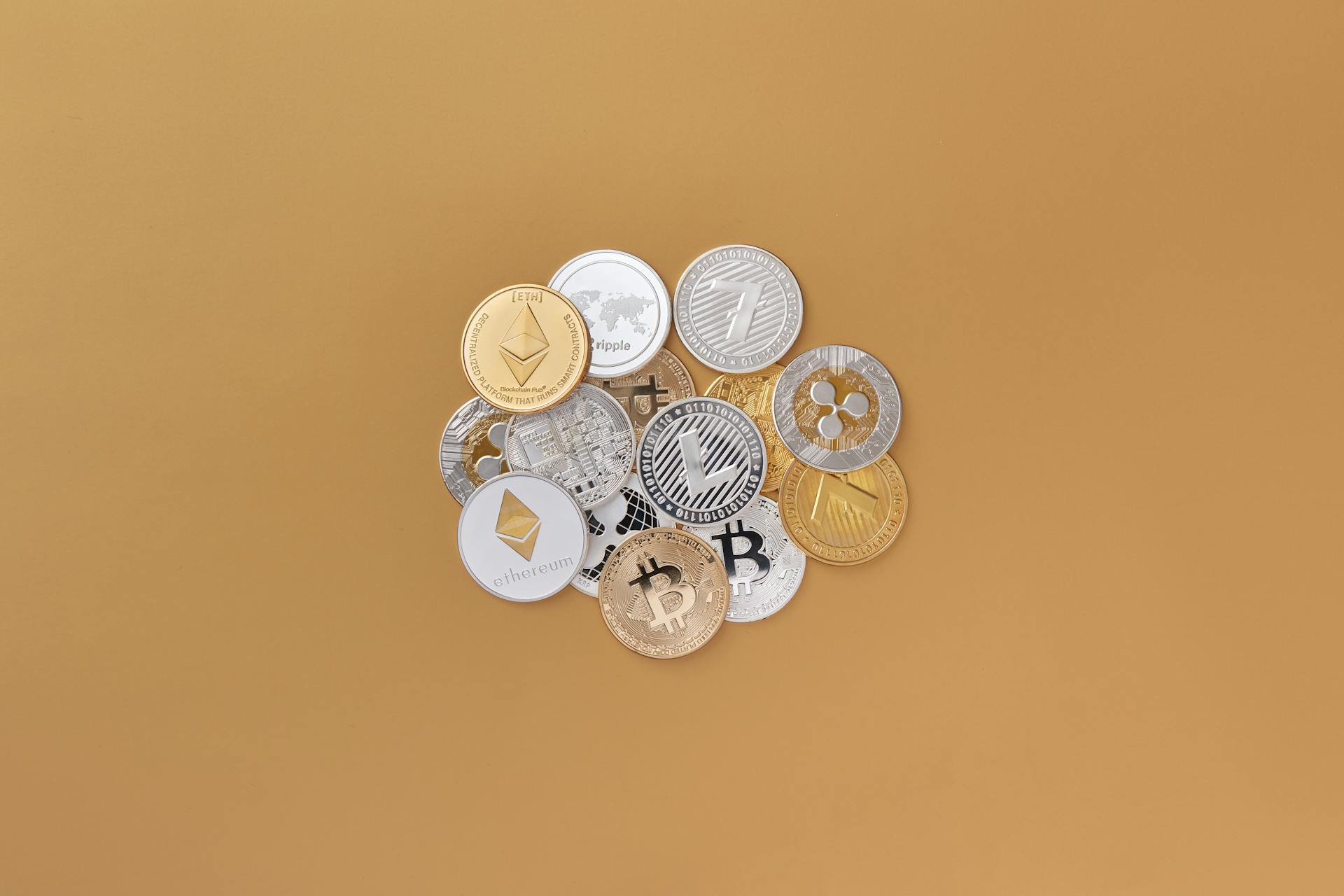
ERC20 is a standard for creating tokens on the Ethereum blockchain, which allows for the creation of new digital assets.
ERC20 tokens are built on top of the Ethereum network and use the same underlying technology, but they are not the same as Ethereum itself.
Ethereum is a decentralized platform for building smart contracts and decentralized applications, while ERC20 tokens are a specific type of token that can be used within those applications.
ERC20 tokens are used for a wide range of purposes, including fundraising, voting, and even loyalty programs.
A fresh viewpoint: What Is Ethereum Used for
What is ERC20 in Full?
ERC20 is a standard for creating fungible tokens on the Ethereum blockchain, allowing developers to create tokens that are interchangeable with one another. This standard was launched in November 2015 by Ethereum developer Fabian Vogelsteller.
The ERC20 token standard provides a common interface for tokens, ensuring compatibility between various tokens in the Ethereum ecosystem. This standard allows developers to create tokens that are compatible with other products and services.
You might enjoy: Create Ethereum Wallet
ERC20 tokens can represent various assets, such as reputation points, digital currencies, shares in a company, or even physical commodities like gold. This versatility enables the creation of various decentralized applications (dApps) and projects built on the Ethereum network.
The ERC20 standard includes six standard functions and rules: totalSupply, balanceOf, transfer, approve, transferFrom, and allowance. These functions allow anyone to create tokens on the Ethereum network with relative ease.
Some popular cryptocurrencies, such as stablecoins USDT and USDC, operate as ERC20 tokens. This has made ERC20 tokens crucial in the Ethereum ecosystem, with applications in decentralized finance, governance, and more.
Ethereum and ERC20
Ethereum and ERC20 are not the same thing, although they're closely related. Ethereum is a blockchain network that enables the creation of decentralized applications (dApps) through smart contracts.
Ethereum's native cryptocurrency, Ether, is the primary fuel for operating and deploying smart contracts on the network. It maintains the integrity of the Ethereum blockchain through its Proof of Stake consensus.
ERC20 tokens, on the other hand, are a technical standard used for creating smart contracts on the Ethereum blockchain. They enable developers to create unique assets with specific functionalities that go beyond just being a digital currency.
Ethereum's Ecosystem
Ethereum's Ecosystem is a vibrant and diverse space where developers can create and innovate. Ethereum is renowned for its smart contract functionality, enabling developers to create decentralized applications (dApps) that run atop its blockchain.
Ethereum's native cryptocurrency, Ether, serves as the 'fuel' for operating and deploying smart contracts. Ether maintains the integrity of the Ethereum blockchain through its Proof of Stake consensus, subsidizes network operation, and acts as a store of value similar to Bitcoin.
ERC-20 tokens are a technical standard used for creating smart contracts on the Ethereum blockchain, predominantly employed for fundraising via initial coin offerings (ICOs). They enable developers to create unique assets with specific functionalities that go beyond just being a digital currency.
ERC-20 tokens ease the creation of complex financial structures, loyalty tokens, and any type of utility token an organization can imagine. This has given birth to a diverse array of tokens, the most notable being Ether and ERC-20 tokens.
Core Differences
Ether is a native token that operates as the backbone of the Ethereum network, with a relatively stable value that can fluctuate but is fundamentally a medium of exchange and a unit of account within Ethereum's ecosystem.
ERC-20 tokens, on the other hand, are revolutionary due to their flexibility, coming in various forms like stablecoins that peg their value to fiat currencies.
Ether holds a foundational role, while ERC-20 tokens are the catalysts for decentralized applications that incorporate more complex financial and operational structures.
ERC-20 tokens revolutionize not just currency, but also property, reputation, identity, and more, making them the bedrock of decentralized finance (DeFi).
Token Standard
The ERC-20 token standard provides a common interface for tokens, ensuring compatibility between various tokens in the Ethereum ecosystem.
ERC-20 tokens are fungible, meaning they're interchangeable with one another, unlike non-fungible tokens (NFTs) which are unique and non-interchangeable.
This standard allows developers to create tokens that are compatible with other products and services, making it a crucial part of the blockchain industry.
ERC-20 tokens can represent various assets, such as reputation points, digital currencies, shares in a company, or even physical commodities like gold.
The ERC-20 standard was launched in November 2015 by Ethereum developer Fabian Vogelsteller, introducing standard functions and rules to support fungible tokens.
Today, the ERC-20 token standard is used in decentralized finance, governance, and more, with many popular cryptocurrencies operating as ERC-20 tokens, including stablecoins like USDT and USDC.
Token Standard
The ERC-20 token standard is a game-changer in the blockchain industry.
ERC-20 is a fungible token standard on the Ethereum blockchain, enabling the creation of interchangeable tokens.
This standard provides a common interface for tokens, ensuring compatibility between various tokens in the Ethereum ecosystem.
ERC-20 tokens can represent various assets, such as digital currencies, shares in a company, or even physical commodities like gold.
The standard was launched in November 2015 by Ethereum developer Fabian Vogelsteller.
It introduced standard functions and rules to support fungible tokens, including totalSupply, balanceOf, transfer, approve, transferFrom, and allowance.
Today, ERC-20 tokens play a crucial role in the Ethereum ecosystem, with applications in decentralized finance, governance, and more.
Many parts of the crypto ecosystem, such as DAOs, DeFi, and NFT marketplaces, rely on fungible crypto tokens.
Some of the most popular cryptocurrencies in existence operate as ERC-20 tokens, particularly stablecoins like USDT and USDC.
The ERC-20 standard ensures that all tokens created on the Ethereum network are interoperable with other tokens.
This standardization has made it easier for developers to create tokens that are compatible with other products and services.
A unique perspective: Ethereum Ecosystem
Token Standard Overview
The ERC-20 token standard is a fungible token standard on the Ethereum blockchain, enabling the creation of interchangeable tokens. This standard provides a common interface for tokens, ensuring compatibility between various tokens in the Ethereum ecosystem.
ERC-20 tokens are critical in the blockchain industry, representing various assets such as reputation points, digital currencies, shares in a company, or even physical commodities like gold. They play a significant role in the creation of decentralized applications (dApps) and projects built on the Ethereum network.
The ERC-20 standard was launched in November 2015 by Ethereum developer Fabian Vogelsteller, introducing standard functions and rules to support fungible tokens. This innovation has become crucial in the Ethereum ecosystem, with applications in decentralized finance, governance, and more.
ERC-20 tokens interact seamlessly with various applications, wallets, and exchanges due to their standardized structure. This standard simplifies token management and reduces the risk of compatibility issues between different projects in the ecosystem.
The ERC-20 standard defines a common set of rules and functions for token creation, simplifying the development process and ensuring consistency across different tokens. This standardized framework allows developers to save time and resources by focusing on their token's unique features instead of building from scratch.
Token Uses and Benefits
ERC-20 tokens offer several benefits for creating fungible tokens on the Ethereum blockchain.
ERC-20 tokens have the capability of exchange - swap, which is a significant advantage for users.
You can create fungible tokens on the Ethereum blockchain using the ERC-20 token standard.
ERC-20 assets possess the capability of exchange, which allows users to swap them.
Check this out: Ethereum Exchange
Token Uses
ERC-20 tokens are incredibly versatile and can represent various assets, such as reputation points, digital currencies, shares in a company, or even physical commodities like gold.
They play a significant role in the blockchain industry, enabling the creation of various decentralized applications (dApps) and projects built on the Ethereum network.
ERC-20 tokens are fungible, meaning they're interchangeable with one another, which is different from non-fungible tokens (NFTs) that are unique and non-interchangeable.
This standard provides a common interface for tokens, ensuring compatibility between various tokens in the Ethereum ecosystem.
ERC-20 tokens can be used to represent various assets, making them a crucial part of the blockchain industry.
Besides the basic functionalities, ERC20 assets also possess the capability of exchange - swap.
Benefits of Tokens
Tokens offer a lot of benefits, and one of the most significant is their fungibility, which means they can be easily exchanged for one another.
ERC-20 tokens, in particular, provide a standardized way to create fungible tokens on the Ethereum blockchain.
USD Coin (USDC)
USD Coin (USDC) is a popular ERC-20 token for DeFi, allowing traders to take profit without moving funds off chain.
It was created by financial solution company Circle and launched in September 2018. USDC is a stablecoin pegged to the US dollar, providing price stability in the volatile world of cryptocurrencies.
USDC plays a role in cross-border payments and is widely used in exchanges as a base trading pair.
Additional reading: Usdc Erc20
0x (Zrx)
0x (ZRX) is a decentralized token trading and exchange platform that allows users to vote on the future of the platform through its utility and governance token.
Launched in 2017 by Will Warren and Amir Bandeali, the 0x protocol has made it possible for users to earn rewards via staking.
As a utility token, ZRX enables users to participate in the governance of the platform, giving them a say in its future development.
ZRX is an ERC-20 token, making it compatible with the Ethereum network and allowing for seamless integration with other decentralized applications.
Broaden your view: 0x (decentralized Exchange Infrastructure)
Standardization
ERC-20 defines a common set of rules and functions for token creation, simplifying the development process and ensuring consistency across different tokens.
This standardization allows developers to save time and resources by focusing on their token's unique features instead of building from scratch.
ERC-20 tokens leverage the power of Ethereum's smart contracts, enabling complex, automated transactions and decentralized applications.
By providing a standardized framework, ERC-20 tokens can interact seamlessly with various applications, wallets, and exchanges, reducing the risk of compatibility issues.
Developers can create tokens that are compatible with other products and services, making it easier to integrate with third-party services like exchanges, payment processors, or portfolio trackers.
This simplifies the development process and makes it easier for developers to create tokens that can be used across different platforms.
Frequently Asked Questions
Can I transfer ERC-20 to ETH?
ERC-20 tokens can be transferred to any Ethereum address, including ETH, but they remain separate assets from ETH itself
Is USDT ERC-20 the same as Ethereum?
USDT ERC-20 is not the same as Ethereum, but it's built on the Ethereum network using the ERC20 token standard. It's a variant of the Tether token that allows for transfer and functionality on the Ethereum chain.
Sources
- https://www.investopedia.com/news/what-erc20-and-what-does-it-mean-ethereum/
- https://trustwallet.com/blog/ethereum-erc20-tokens-explained
- https://www.linkedin.com/pulse/ether-vs-erc-20-unveiling-core-differences-ethereums-ecosystem-guzel-96fzc
- https://blog.thirdweb.com/what-is-erc-20-token/
- https://gemwallet.com/learn/what-is-erc20-and-what-you-need-to-know-about-tokens-on-the-ethereum-blockchain/
Featured Images: pexels.com


